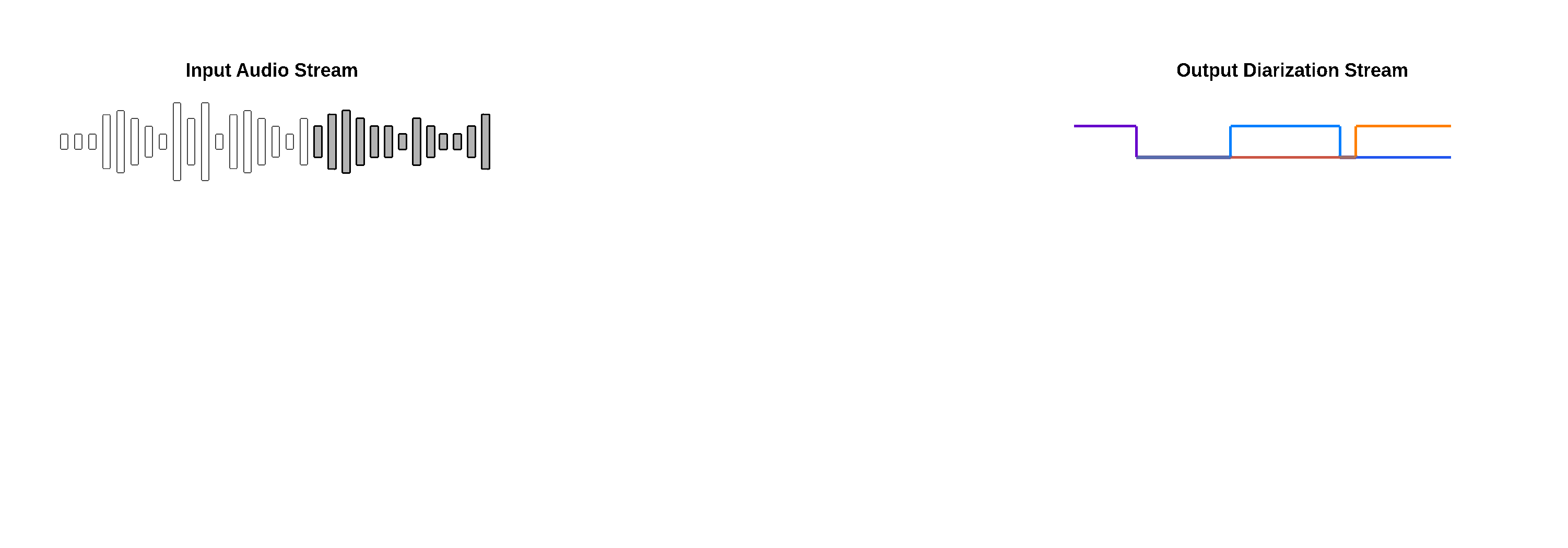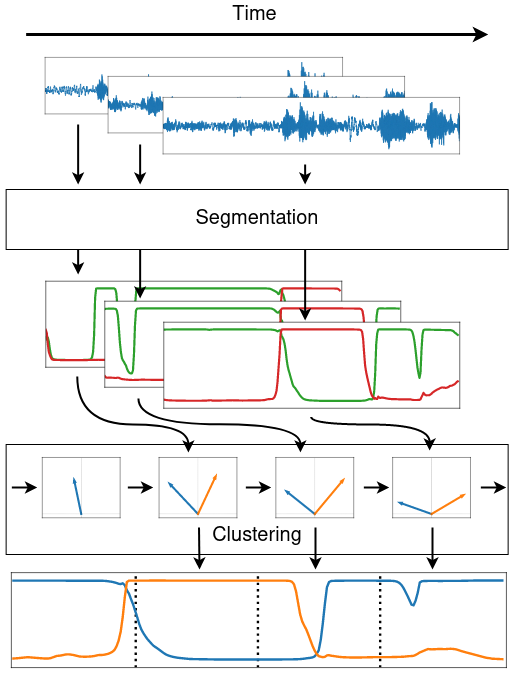Get started with diart#

🌿 Build AI-powered real-time audio applications in a breeze 🌿

⚡ Quick introduction#
Diart is a python framework to build AI-powered real-time audio applications. Its key feature is the ability to recognize different speakers in real time with state-of-the-art performance, a task commonly known as “speaker diarization”.
The pipeline diart.SpeakerDiarization combines a speaker segmentation and a speaker embedding model
to power an incremental clustering algorithm that gets more accurate as the conversation progresses:

With diart you can also create your own custom AI pipeline, benchmark it, tune its hyper-parameters, and even serve it on the web using websockets.
We provide pre-trained pipelines for:
Speaker Diarization
Voice Activity Detection
Transcription (coming soon)
💾 Installation#
1) Make sure your system has the following dependencies:
ffmpeg < 4.4
portaudio == 19.6.X
libsndfile >= 1.2.2
Alternatively, we provide an environment.yml file for a pre-configured conda environment:
conda env create -f diart/environment.yml
conda activate diart
2) Install the package:
pip install diart
Get access to 🎹 pyannote models#
By default, diart is based on pyannote.audio models from the huggingface hub. In order to use them, please follow these steps:
Accept user conditions for the
pyannote/segmentationmodelAccept user conditions for the newest
pyannote/segmentation-3.0modelAccept user conditions for the
pyannote/embeddingmodelInstall huggingface-cli and log in with your user access token (or provide it manually in diart CLI or API).
🎙️ Stream audio#
From the command line#
A recorded conversation:
diart.stream /path/to/audio.wav
A live conversation:
# Use "microphone:ID" to select a non-default device
# See `python -m sounddevice` for available devices
diart.stream microphone
By default, diart runs a speaker diarization pipeline, equivalent to setting --pipeline SpeakerDiarization,
but you can also set it to --pipeline VoiceActivityDetection. See diart.stream -h for more options.
From python#
Use StreamingInference to run a pipeline on an audio source and write the results to disk:
from diart import SpeakerDiarization
from diart.sources import MicrophoneAudioSource
from diart.inference import StreamingInference
from diart.sinks import RTTMWriter
pipeline = SpeakerDiarization()
mic = MicrophoneAudioSource()
inference = StreamingInference(pipeline, mic, do_plot=True)
inference.attach_observers(RTTMWriter(mic.uri, "/output/file.rttm"))
prediction = inference()
For inference and evaluation on a dataset we recommend to use Benchmark (see notes on reproducibility).
🧠 Models#
You can use other models with the --segmentation and --embedding arguments.
Or in python:
import diart.models as m
segmentation = m.SegmentationModel.from_pretrained("model_name")
embedding = m.EmbeddingModel.from_pretrained("model_name")
Pre-trained models#
Below is a list of all the models currently supported by diart:
Model Name |
Model Type |
CPU Time* |
GPU Time* |
|---|---|---|---|
🤗 |
segmentation |
12ms |
8ms |
🤗 |
segmentation |
11ms |
8ms |
🤗 |
embedding |
26ms |
12ms |
🤗 |
embedding |
48ms |
15ms |
🤗 |
embedding |
150ms |
29ms |
🤗 |
embedding |
41ms |
15ms |
🤗 |
embedding |
41ms |
14ms |
🤗 |
embedding |
42ms |
14ms |
🤗 |
embedding |
41ms |
16ms |
🤗 |
embedding |
91ms |
16ms |
The latency of segmentation models is measured in a VAD pipeline (5s chunks).
The latency of embedding models is measured in a diarization pipeline using pyannote/segmentation (also 5s chunks).
CPU: AMD Ryzen 9 - GPU: RTX 4060 Max-Q
Custom models#
Third-party models can be integrated by providing a loader function:
from diart import SpeakerDiarization, SpeakerDiarizationConfig
from diart.models import EmbeddingModel, SegmentationModel
def segmentation_loader():
# It should take a waveform and return a segmentation tensor
return load_pretrained_model("my_model.ckpt")
def embedding_loader():
# It should take (waveform, weights) and return per-speaker embeddings
return load_pretrained_model("my_other_model.ckpt")
segmentation = SegmentationModel(segmentation_loader)
embedding = EmbeddingModel(embedding_loader)
config = SpeakerDiarizationConfig(
segmentation=segmentation,
embedding=embedding,
)
pipeline = SpeakerDiarization(config)
If you have an ONNX model, you can use from_onnx():
from diart.models import EmbeddingModel
embedding = EmbeddingModel.from_onnx(
model_path="my_model.ckpt",
input_names=["x", "w"], # defaults to ["waveform", "weights"]
output_name="output", # defaults to "embedding"
)
📈 Tune hyper-parameters#
Diart implements an optimizer based on optuna that allows you to tune pipeline hyper-parameters to your needs.
From the command line#
diart.tune /wav/dir --reference /rttm/dir --output /output/dir
See diart.tune -h for more options.
From python#
from diart.optim import Optimizer
optimizer = Optimizer("/wav/dir", "/rttm/dir", "/output/dir")
optimizer(num_iter=100)
This will write results to an sqlite database in /output/dir.
Distributed tuning#
For bigger datasets, it is sometimes more convenient to run multiple optimization processes in parallel. To do this, create a study on a recommended DBMS (e.g. MySQL or PostgreSQL) making sure that the study and database names match:
mysql -u root -e "CREATE DATABASE IF NOT EXISTS example"
optuna create-study --study-name "example" --storage "mysql://root@localhost/example"
You can now run multiple identical optimizers pointing to this database:
diart.tune /wav/dir --reference /rttm/dir --storage mysql://root@localhost/example
or in python:
from diart.optim import Optimizer
from optuna.samplers import TPESampler
import optuna
db = "mysql://root@localhost/example"
study = optuna.load_study("example", db, TPESampler())
optimizer = Optimizer("/wav/dir", "/rttm/dir", study)
optimizer(num_iter=100)
🧠🔗 Build pipelines#
For a more advanced usage, diart also provides building blocks that can be combined to create your own pipeline.
Streaming is powered by RxPY, but the blocks module is completely independent and can be used separately.
Example#
Obtain overlap-aware speaker embeddings from a microphone stream:
import rx.operators as ops
import diart.operators as dops
from diart.sources import MicrophoneAudioSource
from diart.blocks import SpeakerSegmentation, OverlapAwareSpeakerEmbedding
segmentation = SpeakerSegmentation.from_pretrained("pyannote/segmentation")
embedding = OverlapAwareSpeakerEmbedding.from_pretrained("pyannote/embedding")
mic = MicrophoneAudioSource()
stream = mic.stream.pipe(
# Reformat stream to 5s duration and 500ms shift
dops.rearrange_audio_stream(sample_rate=segmentation.model.sample_rate),
ops.map(lambda wav: (wav, segmentation(wav))),
ops.starmap(embedding)
).subscribe(on_next=lambda emb: print(emb.shape))
mic.read()
Output:
# Shape is (batch_size, num_speakers, embedding_dim)
torch.Size([1, 3, 512])
torch.Size([1, 3, 512])
torch.Size([1, 3, 512])
...
🌐 WebSockets#
Diart is also compatible with the WebSocket protocol to serve pipelines on the web.
From the command line#
diart.serve --host 0.0.0.0 --port 7007
diart.client microphone --host <server-address> --port 7007
Note: make sure that the client uses the same step and sample_rate than the server with --step and -sr.
See -h for more options.
From python#
For customized solutions, a server can also be created in python using the WebSocketAudioSource:
from diart import SpeakerDiarization
from diart.sources import WebSocketAudioSource
from diart.inference import StreamingInference
pipeline = SpeakerDiarization()
source = WebSocketAudioSource(pipeline.config.sample_rate, "localhost", 7007)
inference = StreamingInference(pipeline, source)
inference.attach_hooks(lambda ann_wav: source.send(ann_wav[0].to_rttm()))
prediction = inference()
🔬 Powered by research#
Diart is the official implementation of the paper Overlap-aware low-latency online speaker diarization based on end-to-end local segmentation by Juan Manuel Coria, Hervé Bredin, Sahar Ghannay and Sophie Rosset.
We propose to address online speaker diarization as a combination of incremental clustering and local diarization applied to a rolling buffer updated every 500ms. Every single step of the proposed pipeline is designed to take full advantage of the strong ability of a recently proposed end-to-end overlap-aware segmentation to detect and separate overlapping speakers. In particular, we propose a modified version of the statistics pooling layer (initially introduced in the x-vector architecture) to give less weight to frames where the segmentation model predicts simultaneous speakers. Furthermore, we derive cannot-link constraints from the initial segmentation step to prevent two local speakers from being wrongfully merged during the incremental clustering step. Finally, we show how the latency of the proposed approach can be adjusted between 500ms and 5s to match the requirements of a particular use case, and we provide a systematic analysis of the influence of latency on the overall performance (on AMI, DIHARD and VoxConverse).

Citation#
If you found diart useful, please make sure to cite our paper:
@inproceedings{diart,
author={Coria, Juan M. and Bredin, Hervé and Ghannay, Sahar and Rosset, Sophie},
booktitle={2021 IEEE Automatic Speech Recognition and Understanding Workshop (ASRU)},
title={Overlap-Aware Low-Latency Online Speaker Diarization Based on End-to-End Local Segmentation},
year={2021},
pages={1139-1146},
doi={10.1109/ASRU51503.2021.9688044},
}
Reproducibility#

Important: We highly recommend installing pyannote.audio<3.1 to reproduce these results.
For more information, see this issue.
Diart aims to be lightweight and capable of real-time streaming in practical scenarios. Its performance is very close to what is reported in the paper (and sometimes even a bit better).
To obtain the best results, make sure to use the following hyper-parameters:
Dataset |
latency |
tau |
rho |
delta |
|---|---|---|---|---|
DIHARD III |
any |
0.555 |
0.422 |
1.517 |
AMI |
any |
0.507 |
0.006 |
1.057 |
VoxConverse |
any |
0.576 |
0.915 |
0.648 |
DIHARD II |
1s |
0.619 |
0.326 |
0.997 |
DIHARD II |
5s |
0.555 |
0.422 |
1.517 |
diart.benchmark and diart.inference.Benchmark can run, evaluate and measure the real-time latency of the pipeline. For instance, for a DIHARD III configuration:
diart.benchmark /wav/dir --reference /rttm/dir --tau-active=0.555 --rho-update=0.422 --delta-new=1.517 --segmentation pyannote/segmentation@Interspeech2021
or using the inference API:
from diart.inference import Benchmark, Parallelize
from diart import SpeakerDiarization, SpeakerDiarizationConfig
from diart.models import SegmentationModel
benchmark = Benchmark("/wav/dir", "/rttm/dir")
model_name = "pyannote/segmentation@Interspeech2021"
model = SegmentationModel.from_pretrained(model_name)
config = SpeakerDiarizationConfig(
# Set the segmentation model used in the paper
segmentation=model,
step=0.5,
latency=0.5,
tau_active=0.555,
rho_update=0.422,
delta_new=1.517
)
benchmark(SpeakerDiarization, config)
# Run the same benchmark in parallel
p_benchmark = Parallelize(benchmark, num_workers=4)
if __name__ == "__main__": # Needed for multiprocessing
p_benchmark(SpeakerDiarization, config)
This pre-calculates model outputs in batches, so it runs a lot faster.
See diart.benchmark -h for more options.
For convenience and to facilitate future comparisons, we also provide the expected outputs of the paper implementation in RTTM format for every entry of Table 1 and Figure 5. This includes the VBx offline topline as well as our proposed online approach with latencies 500ms, 1s, 2s, 3s, 4s, and 5s.

📑 License#
MIT License
Copyright (c) 2021 Université Paris-Saclay
Copyright (c) 2021 CNRS
Permission is hereby granted, free of charge, to any person obtaining a copy
of this software and associated documentation files (the "Software"), to deal
in the Software without restriction, including without limitation the rights
to use, copy, modify, merge, publish, distribute, sublicense, and/or sell
copies of the Software, and to permit persons to whom the Software is
furnished to do so, subject to the following conditions:
The above copyright notice and this permission notice shall be included in all
copies or substantial portions of the Software.
THE SOFTWARE IS PROVIDED "AS IS", WITHOUT WARRANTY OF ANY KIND, EXPRESS OR
IMPLIED, INCLUDING BUT NOT LIMITED TO THE WARRANTIES OF MERCHANTABILITY,
FITNESS FOR A PARTICULAR PURPOSE AND NONINFRINGEMENT. IN NO EVENT SHALL THE
AUTHORS OR COPYRIGHT HOLDERS BE LIABLE FOR ANY CLAIM, DAMAGES OR OTHER
LIABILITY, WHETHER IN AN ACTION OF CONTRACT, TORT OR OTHERWISE, ARISING FROM,
OUT OF OR IN CONNECTION WITH THE SOFTWARE OR THE USE OR OTHER DEALINGS IN THE
SOFTWARE.
Logo generated by DesignEvo free logo designer




